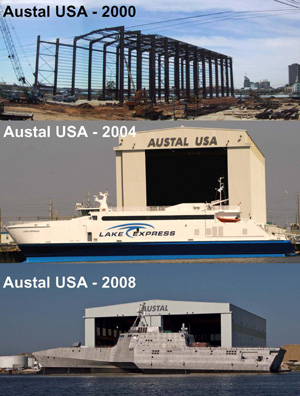
Posted on 03/28/2011 11:46:34 AM PDT by sukhoi-30mki
Austal sees smaller LCS for RAN
AAP
March 25, 2011, 11:11 am
Shipbuilder Austal is proposing a smaller version of its revolutionary US Navy Littoral Combat Ship as the Australian navy's next generation warship.
Austal chief executive Andrew Bellamy, in Canberra for meetings with defence officials, said the company was now constructing 10 LCSs for the US under a $US3.7 billion ($A3.63 billion) contract announced last year.
Under the 2009 Defence White Paper, Australia's existing navy patrol boats, minehunters and hydrographic vessels will be replaced by 20 multi-role vessels (MRVs) with the first scheduled to enter service around 2019.
"Our view is that MRV is perfectly suited to a smaller version of the LCS," Mr Bellamy said.
Austal has constructed a 102-metre trimaran on spec to showcase this new type of vessel.
"That's our strategy. It's smaller but cheaper (than the LCS), with lower operating cost but a similar sort of capability," he said.
"This ship is very flexible, very versatile, high speed, relatively low cost."
Austal, based in Henderson, WA, started out in 1988 building fishing boats and then expanded into the lucrative global market for high speed aluminium hull passenger ferries, as did Tasmanian firm Incat.
In 2000, the company moved into the US, establishing a shipyard in Alabama to build vessels for the US Navy. Under the US Jones Act, any US-flagged vessel has to be constructed in the US.
That rules out Australian construction, although the vessels were designed in Australia and the US yard remains wholly owned by Austal.
In 2008, Austal was awarded a $US1.6 billion contract to build 10 high speed transport
(Excerpt) Read more at au.news.yahoo.com ...

Don’t try to buy any of those used German ships! They must be made out of gold!
 The Austal high speed ferry on Lake Michigan - built in Mobile, AL.
The Austal high speed ferry on Lake Michigan - built in Mobile, AL.
 http://nextnavy.com/shipyards-tea-leaves-and-the-lcs-austal-is-gonna-win/
http://nextnavy.com/shipyards-tea-leaves-and-the-lcs-austal-is-gonna-win/
Disclaimer: Opinions posted on Free Republic are those of the individual posters and do not necessarily represent the opinion of Free Republic or its management. All materials posted herein are protected by copyright law and the exemption for fair use of copyrighted works.